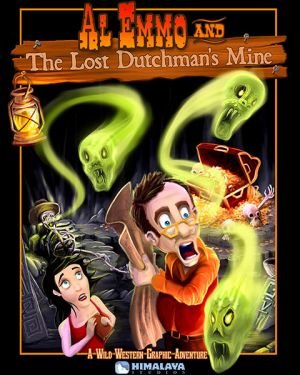Review for Al Emmo and the Lost Dutchman’s Mine
It's a scenario we've all seen a hundred times in movies and on television. One of the characters has finally managed to land a date with a beautiful girl, but only if he can also find a date for her not-so attractive friend. So he hits up his buddy to go out with her, and when asked what she looks like, he responds that she has a good personality. That may sound like a rather random introduction to an adventure game review, but when my girlfriend asked me last week how I was enjoying Al Emmo and the Lost Dutchman's Mine, the first thing that popped out of my mouth was that it has a great personality.
Al Emmo is the first retail game from Himalaya Studios, the independent developer whose founding members were responsible for wowing us all with their remakes of the first two King's Quest games. And while it is evident that the same love that went into those games also went into Al Emmo, somewhere along the line they seem to have taken a misstep that keeps the game from being the great original debut that it could have been.
The story begins with an introductory scene in which two men and their team have finally come to the end of their quest to find a lost mine filled with Aztec gold. From there we move to the present, as our main character Al Emmo arrives by train in the small town of Anozira to meet his mail order bride. Al is your stereotypical nebbish character, with his comb-over hairdo, ill-fitting clothes, bad posture, and annoying voice. And, because this is an adventure game, once Al arrives in town, everything begins to go wrong almost immediately. Left without a bride, Al soon falls for a bar singer named Rita, and over the course of the nine act story, must fight for her love against a swarthy lothario by the name of Antonio Bandana, and discover the secret of The Dutchman's Mine and its treasures.
My first thought when the story started coming together was that it could easily be the plot for "Leisure Suit Larry 9: Wild West Larry", and combined with the nerdy character of Al Emmo, the comparisons get even closer. But while it treads some of the same ground as that classic Sierra series, Himalaya does manage to distance itself from those games by creating a town filled with pop culture references and a memorable cast of characters, from a missile-wielding gopher to a cola-addicted Indian chief, and an exterminator ready to take his war against termites to the extreme, just to name a few.
In any comedy adventure game, the impact of its humor is going to be subjective. I personally found Al Emmo's story to be funny, and there were a few laugh-out-loud moments to be had. Himalaya went with the "throw a bunch of jokes out and see what sticks" concept, and of course not everything worked, but I thought they did a good job of toeing the line between amusing jokes and groaners.
It's a shame, then, that some people won't make it far enough into the story to see how good it is, having been immediately turned off by the game's graphics. When I saw the Himalaya logo come up on the screen -- also evocative of the Sierra logo, but frankly much cooler looking -- I was ready to be amazed. And when the introductory 3D cutscene started and the first characters came on the screen, I was heartbroken. The design of the characters was incredibly generic, their rendering was awful, and the characters moved like they were stuck in molasses. As the scene shifted to modern day, once again I was dumbstruck by the amateur quality of the presentation. At that point, had I not been reviewing the game, it would have been relegated to my stack of "I'll play those later" games. Fortunately, it turns out that only the introduction and first act cinematics are done in this style. The rest of the game's cutscenes are done as a series of comic panels, each looking very much like Italian comic art, and I was blown away by how good they were and how much they pulled me further into the story. I only wish the introductions had been redone in this format, as it wouldn't have been so jarring to switch styles, and certainly would have made a much better first impression.
Once the gameplay actually starts, things begin to look a little better. For starters, the background graphics are full of gorgeous handpainted screens, and even when traveling through a desert area, the screens all manage to have a unique look to them, filled with little touches that you may not notice immediately but will catch over time as you travel through them again. Regrettably, the game is presented in 640x400 resolution, which lessens the effectiveness of the visuals considerably. The portrait graphics used when conversing with characters are not great, but well done, and add a nice touch. However, the characters themselves are rendered in 3D, and fare just as badly as their cutscene counterparts. Minor characters in most cases don't seem to have any form to them, with arms and legs made up of simple tubes with a head and boots. And while the major characters are a little better, they don't blend in well with the background graphics, and they move like they're underwater. Since you'll be seeing a lot of Al running from screen to screen, this gets old fast.
The voice work in the game is for the most part really good. The characters all sound very much like you would expect them to from their portraits, and although some of them are rather blatantly stereotypical, they are all good for a laugh at some point in the game. Perhaps most notable are the narrator, who has a perfect air of pomposity for the job, and a frontier teenage geek who is obsessed with telegraphs and cryptography. With that being said, however, another polarizing aspect of the game is going to be the voice of Al himself. While the voice fits the visual caricature, spending the entire game listening to his high-pitched, nasal whining will likely lead some people to stop playing entirely, or at least turn off the sound, missing out on the other great characters in the process. After a bit of time spent with the game, though, the voice didn't really bother me as much, and by the end of the game I really didn't notice it at all. So keep that in mind if you've played through the demo and feel discouraged from purchasing the full game based on that limited experience.
On the music front, there's not much to be said. I found the score fairly negligible, consisting mostly of variations on old west themes that we've heard in pretty much every western game that's come out before this one. On top of that, there are quite a few areas where there is no music at all, or areas where I had to turn my speakers up all the way to hear that there was music playing.
But we're gamers, and in the end that's what matters most, and this is where Al Emmo really comes out and shines. Maybe it's all the time spent working on the King's Quest remakes, but Himalaya definitely knows how to pull off an old school adventure game. Navigation is handled through a standard point-and-click interface in which left clicking moves Al while right clicking cycles the cursor through look, touch, and speak actions, plus the active inventory item. Various menus and options are accessed by moving the mouse into the corners of the screen, including a map of locations that you've visited. If you click on a location, you'll be instantly transported there. This is a helpful feature, especially later in the game when you'll be revisiting many of the locations that you've been to before.
Puzzles are, with a few exceptions, all inventory-based, although there are a few light action sequences. There are a few clunkers in the bunch, but most of the puzzles that I came up against maintained the right balance between challenging and frustrating. Even in cases where they did not push the story along, they were always humorous and engaging. One thing to keep in mind is that many of the items you'll need to pick up blend into the backgrounds, so there are some instances where you'll be going screen to screen clicking on everything to make sure you haven't missed anything. Compounding this issue is the fact that, unlike most current games, there's no smart cursor revealing hotspots and items, so absolutely everything visible is a potential interaction. But just like the older adventures it emulates, Himalaya has added humorous responses to what seems like everything in the game, with either Al or the narrator commenting on your every action. This sense of interactivity and humor does a great job of keeping you in the game, rewarding careful exploration. There are also people that you'll need to converse with multiple times before you get the information you need. One puzzle in particular had me scratching me head until I went back one more time to talk to a character, who finally presented me with a solution.
While I was quite impressed with the content of the game, Al Emmo and the Lost Dutchman's Mine is probably one of the tougher games to recommend, as much will depend on what people expect. For those seeking a complete throwback to the classic adventures of old, Al Emmo certainly delivers in many respects. But those hoping for any kind of contemporary presentation to complement its nostalgic gameplay will be sorely disappointed. Even overlooking the low technical aspects, I wonder if people will be able to get past the protagonist's voice and the poor character design and movement in order to enjoy it fully. If you do decide to take on Al's grand quest, you'll be treated to a highly interactive, classic-styled comic adventure that should take around eight hours or so your first time through. The asking price of $29.99 at the Himalaya online store is a little steep for the length of the game, but if you have any fondness at all for the genre's glory years, I think you'll find it's ultimately worth it.



_capsule_fog__medium.png)
























